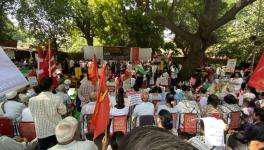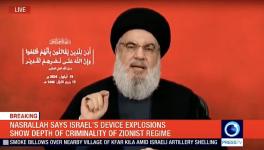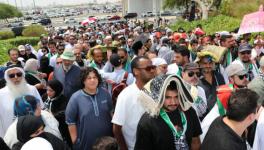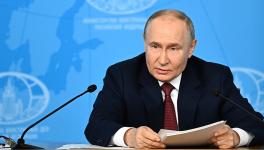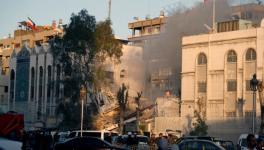Aramco Strike: The Days of US Dominance in West Asia Are Over

Image Courtesy: Al Jazeera
The intricate war dance among the US, the Saudis and Iran on the Houthi attack on Aramco oil installations may still not lead to a shooting war in West Asia. The Saudi defence ministry spokesman Col Turki al-Malki said the attack was unquestionably “sponsored” by Iran – this is quite different from saying that Iran actually launched the attack. Even the US is now using language such as Iran was “behind the attack”, and following up such statements with fresh sanctions on Iran – indicating that the “locked and loaded” gun that President Trump had tweeted earlier may not be fired now.
Houthis have shown to the Saudis that its mastery over drones have create new conditions. As I wrote a few weeks back in these columns, drones and missiles with mobile launchers, make it possible for weaker forces to inflict unacceptable damage on much stronger countries attacking them. This has shifted the strategic balance in various theatres of war, which countries with much greater fire power have yet to register. This is the new strategic balance between Houthis and Saudis; Hezbollah and Israel; and on a wider scale, Iran-Hezbollah-Houthis and the US-Israel-Saudis. None of the weaker forces have to win: they only need the ability to keep fighting, while imposing unacceptable costs on the other side.
The Aramco facilities in Abqaiq and Khurais damaged by the Houthi attack, has taken out 5.7 barrels per day – or 50% – of the Saudi oil production. The Saudis currently produce 12% of the world’s oil, and any longterm damage to its oil installations has huge consequences for the world’s oil supply, as well its price. In spite of the Saudis saying that they have enough stocks to meet the shortfall of supply and the US releasing its strategic reserves of oil to the market, the oil price immediately jumped by $10, or nearly 20%, making it clear how important Saudi oil production is to the global economy. With continuing US illegal sanctions on Venezuela and Iran, the world is now critically dependent on oil from the Saudis, who have promised to increase production to meet the shortfall. Any hit on this supply will have global repercussions and drive the world into a new recession.
Also read: Drone Attacks Strike Major Saudi Aramco Facility, Oilfield
For India, the consequences are more dire. India imports more than 80% of its crude oil. We have cravenly followed the US “orders” on Iran and Venezuela sanctions, and are now even more dependent on the Saudis. The US offer for shale oil is no solution to the Indian economy, as shale oil is much more costly and will drive our balance of payments deep into the red. Unfortunately, jettisoning Iran under Trump’s diktat has serious consequences for India.
The Houthis have shown that the days when Saudis lorded it over Yemen’s airspace, bombing Houthi forces and civilian centres at will, have consequences. The Houthi drone strikes can now hit the soft Saudi underbelly – its oil installations, power plants and desalination facilities. Armed by the NATO powers, Saudi Arabia has overwhelming air dominance over the Houthis. Its defence spending is next only to the US and China, and more than India’s, which is in the 4th place. The Saudis spend $70 billion on its defence, compared to Iran’s $6.3 billion, or less than a tenth of the Saudi expenditure. Certainly the Houthis cannot defend themselves from Saudi air attacks, but neither can Saudi Arabia against drone or cruise missile attacks that hug the ground and defeat easy detection by radar.
After the Iraq war and the then Secretary of State Colin Powell’s ‘Oscar-winning performance’ on Iraq’s Weapons of Mass Destruction in the UN, the bible thumping, current Secretary Pompeo’s claim that it was Iran who dunnit, will carry very little conviction with the rest of the world. The coastline facing Iran has a very dense set of radar networks, the US Fifth Fleet headquarters in Bahrain, the al Udeid Airbase in Qatar of the US Airforce Central Command, as well as numerous Saudi radar installations. They should have detected such a strike coming over the open waters of the Persian Gulf. That the US and the Saudis have produced no such evidence tells its own tale.
The Saudis are now claiming that Iran was “behind the attack”, and a climb down from blaming Iran directly. Their spokesperson, Turki al-Malki said in his press conference that the drone and cruise missile attack came from the north, meaning that the drone swarm that hit Aramco did not come from the direction of Yemen. This is very thin evidence, as we know that drones do not need to fly in a straight line, and can hit a target from any direction irrespective from where it originated. Neither does it prove that if it came from the north, it must have come from Iran. Even the BBC was forced to say that this ducked the essential question: were the weapons used in the attacks against the Saudi oil installations actually fired from Iranian soil?
Also read: Saudi Aramco Attack: US ‘Locked and Loaded' to Punish Those Responsible, Says Trump
While the Saudis have presented the debris of the missiles and drones, showing a fallen wing of a missile and calling it Iranian or calling the data inside the “computer” Iranian can at best prove that Iran did transfer drone technology to Houthis. To present this transfer of drone technology as somehow a smoking gun against Iran, simply overlooks that it is not technology that the US, France and UK have transferred to Saudis but real aircraft, bombs and missiles that has devastated Yemen.
The attack from the Houthis on Aramco was not an isolated one. They have been carrying out a series of drone attacks on Saudi Arabia for the past few months, testing their capabilities and probing the Saudi defence. Open source information on the type of radar, air defence systems and the centres protected by Saudis show that, while the Saudis have some capability in defending against air attack by conventional means – bombers and other attack aircraft – they have very little defence against drone attacks. Most of their air defence is based on the assumption that the only serious threat they have is from Iran, that too using aircraft and conventional missiles. What the Houthis have shown is that in the age of asymmetric war, there are cheaper attack options using UAVs – unmanned air vehicles – or drones. The Saudis have little or no defence against such attacks.
A number of people have written about open source drones, its guidance systems and the small piston or jet engines that are commercially available. All these can be used to create a viable drone that can do what Houthis claim they have done. And all of it for about $20,000 tops.
Creating such drones might have required Iranian knowledge or technology transfer to the Houthis, as the western media and their strategic analysts are claiming. But why exactly should Iran, under illegal sanction from the US and strangling its economy, not arm the Houthis against the Saudis? Particularly, as the aircraft and missiles sold by the US, France and the UK have been repeatedly used against the Yemenis including their civilian centres.
The western media has extensively covered the UN Report that has talked about Iran’s involvement in Houthi drone program. What has yet to find similar coverage, is that the same report also shows that laser guidance missile systems from the US and UK have been used in attacks on civilians that breached international humanitarian law. And they were launched from aircraft that only the Saudis possessed in the region. It is the NATO countries that have armed the Saudi airforce in carrying out about 20,000 bombings on the Yemenis, supplying the bulk of its $70 billion arms acquisition, with the US alone supplying Saudi Arabia with more than 80% of its imported arms. The asymmetric nature of the coverage shows that the western media is “manufacturing consent” on a worldwide scale for their military industrial complex and their security state establishment.
The importance of Saudi Arabia to the US and its allies is that Saudi Arabia underwrites the dollar, and makes it possible for the US and the western financial institutions to control the global financial order. But the days of US strategic dominance over the West Asia are now over. Centre for Strategic Studies, a US think-tank writes, “Looking further into the future, the strikes on Saudi Arabia provide a clear strategic warning that the US era of air supremacy in the Gulf, and the near U.S. monopoly on precision strike capability, is rapidly fading.”
Also watch: Saudi Arabia Losing Ground and Allies in its War on Yemen
Yes, the US can destroy Iran, but cannot save the region and its oil infrastructure from destruction as well. If Iran’s infrastructure is destroyed, the oil infrastructure of its allies will not survive either. This is Iran’s Samson option. This is the new strategic balance, and sooner the US and its NATO partners accept it, the quicker can we look for peace in the region. We can have either collective security or no security in the region. That is the lesson from the current events in Yemen and Saudi Arabia.
Get the latest reports & analysis with people's perspective on Protests, movements & deep analytical videos, discussions of the current affairs in your Telegram app. Subscribe to NewsClick's Telegram channel & get Real-Time updates on stories, as they get published on our website.










